Green has emerged as the ultimate dining-room chameleon, shifting from muted sage to jewel-tone emerald while always offering a sense of freshness, balance, and appetite-boosting vibrancy. Color psychologists link the hue to renewal and calm, making it an intuitive backdrop for lingering meals and lively conversation. Trend forecasters even label sage green the “new neutral” for 2025, noting how easily it pairs with warm woods, metals, and tonal textiles. Deep forest tints lend cocoon-like drama, whereas light mints bounce daylight around compact spaces. Whether you prefer leaf-printed wallpaper or a single statement pendant, a green dining room lets nature’s palette pull the whole scheme together and keep it feeling timeless.
1. Sage Green Dining Room Walls That Act Like a Neutral
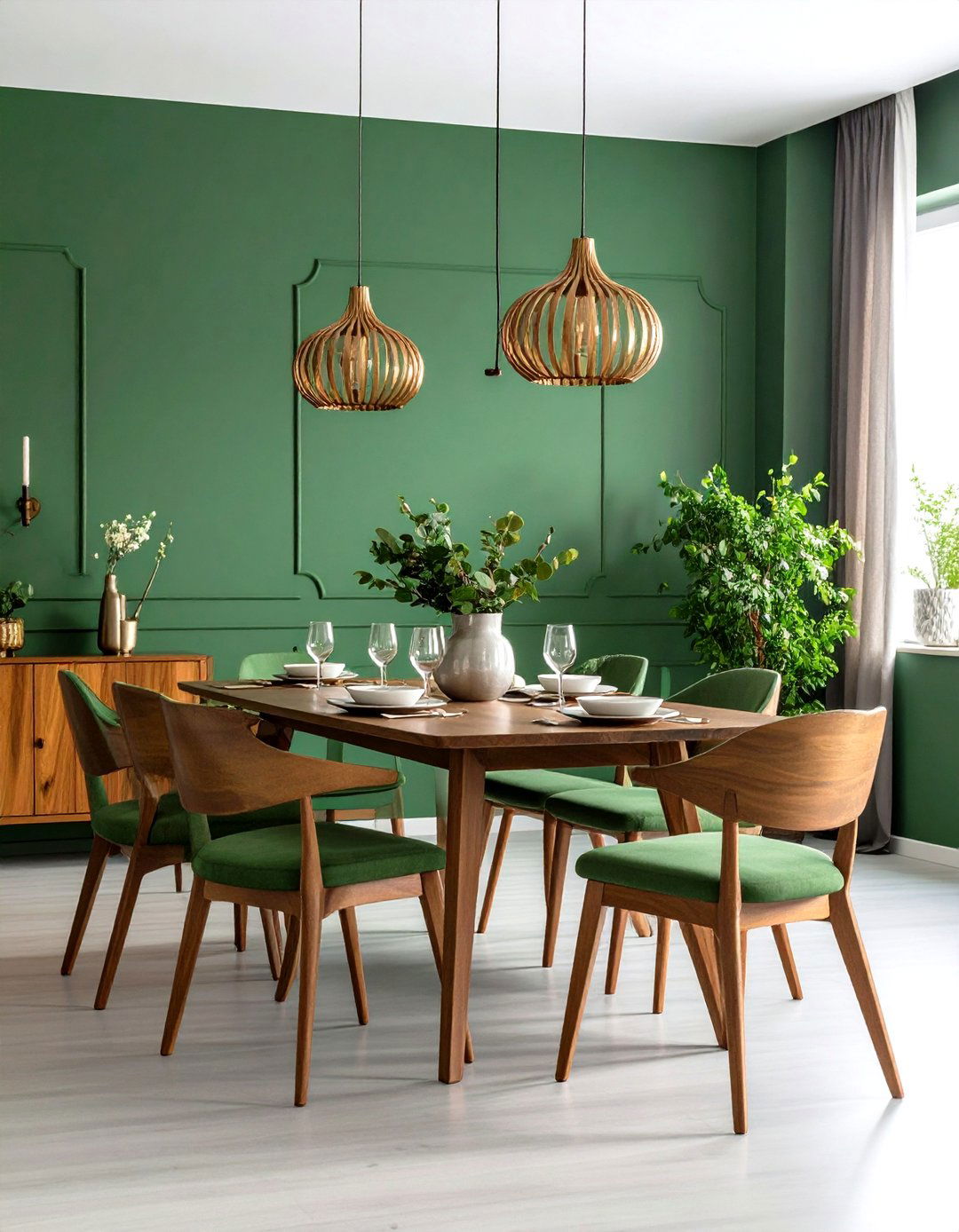
A subtle sage wash instantly wraps a green dining room in serenity while behaving much like beige or taupe when you start layering art, linens, and metallic fixtures. Designers recommend matte finishes with a hint of gray so the walls recede and allow sculptural wood chairs or a dramatic chandelier to become the stars. Because sage is considered a nature-connected neutral, you can confidently mix oak, rattan, or black metal without clashing, making seasonal updates easy. Try painting trim in the same shade to create an enveloping effect, then punctuate the room with crisp white dishes and leafy centerpieces for cohesive calm.
2. Emerald Green Dining Room Glamour with Gold Accents

Unlike softer sages, an emerald green dining room promises pure drama, and pairing the jewel tone with gold hardware instantly elevates the space. Start with a velvet-upholstered chair set or even a glossy lacquer sideboard so the color reflects candlelight at dinner. Brushed-brass wall sconces, warm metallic flatware, and a vintage gilt mirror distribute hints of gold around the room, ensuring the scheme feels curated rather than flashy. Because emerald naturally reads luxurious, keep table linens simple—think ivory runners and crisp porcelain—to let the saturation steal the spotlight. Finish with a single brass pendant for a cohesive, jewel-box effect.
3. Living-Wall Green Dining Room for Instant Biophilia
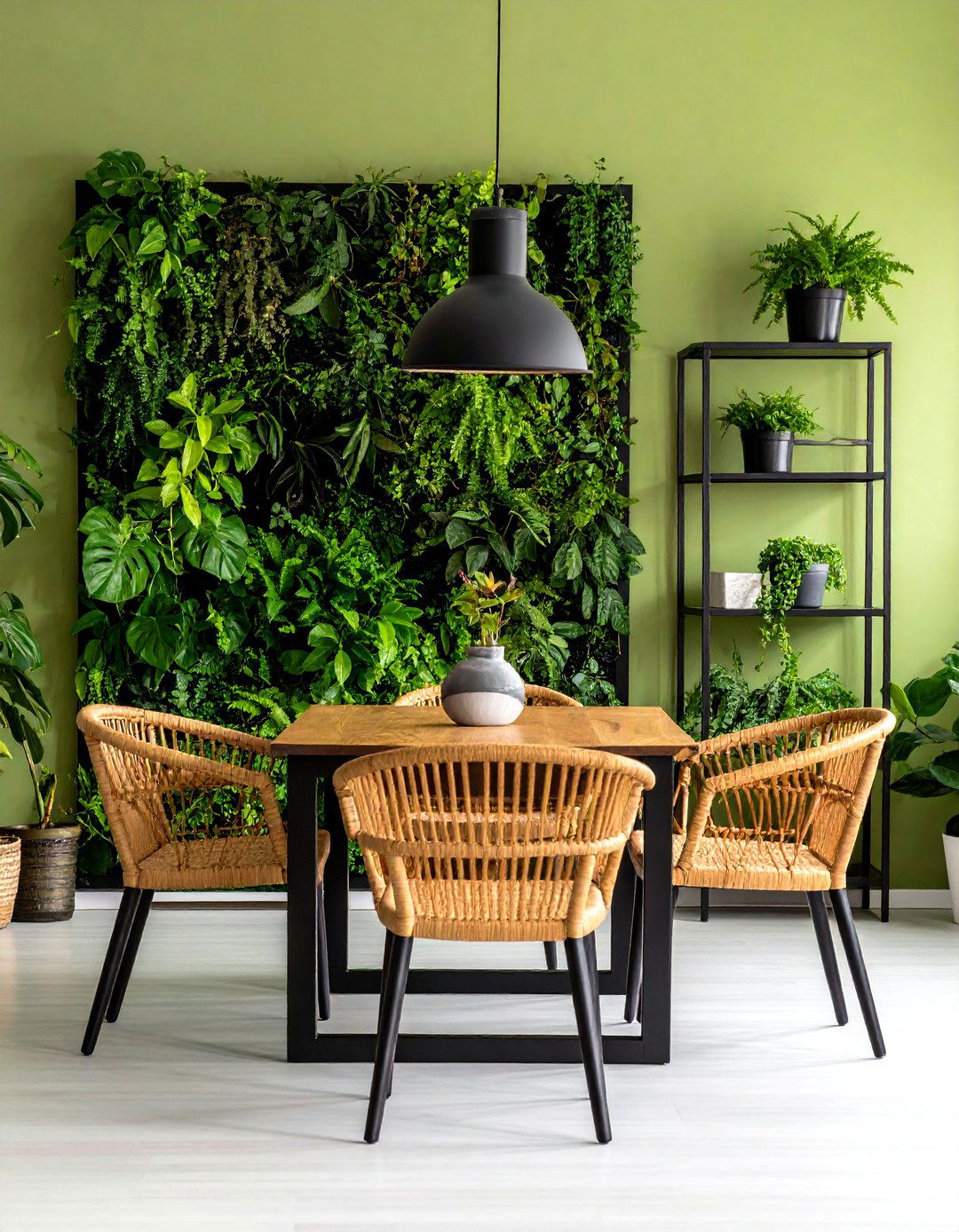
Studies show that surrounding yourself with real foliage can cut airborne microbes by half, so installing a living wall behind the dining table turns a green dining room into a literal fresh-air machine. Modular planters let you weave trailing pothos, ferns, and herbs into a dense, ever-changing tapestry; the vegetation doubles as a conversation piece and a source of garnish for meals. Keep the supporting palette quiet—olive paint on adjacent walls and matte black shelving allow the plants’ tones to dominate. Add discreet uplighting to graze the leaves at night, then swap standard chairs for breathable cane to echo the organic mood.
4. Botanical Green Dining Room Wallpaper for Depth
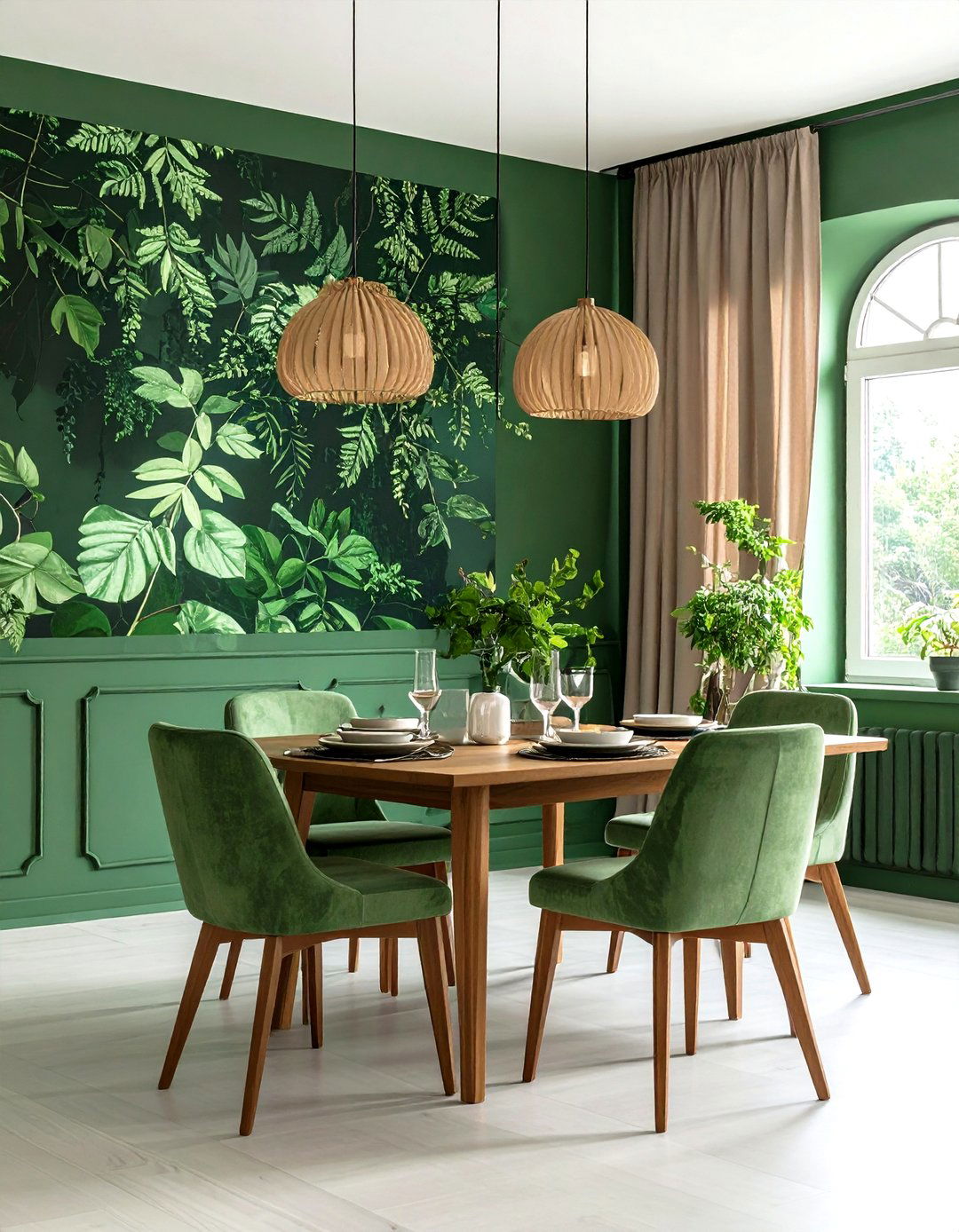
Nothing delivers instant depth like a botanical print wallpaper wrapping your green dining room in stylized leaves and vines. Darker forest backgrounds recede visually, making the room feel larger, while pale mint motifs read bright and airy. For balance, choose simple shaker-style wainscoting or a half-height dado in one of the print’s lighter greens so your eye gets a place to rest. Upholster seats in a neutral linen so patterns don’t compete, and pick up the foliage theme in small ways—a fern-filled vase or bamboo-handled flatware. Because the artwork is built into the walls, you can keep decor minimal yet layered.
5. Reclaimed-Wood Furniture for an Eco-Minded Green Dining Room
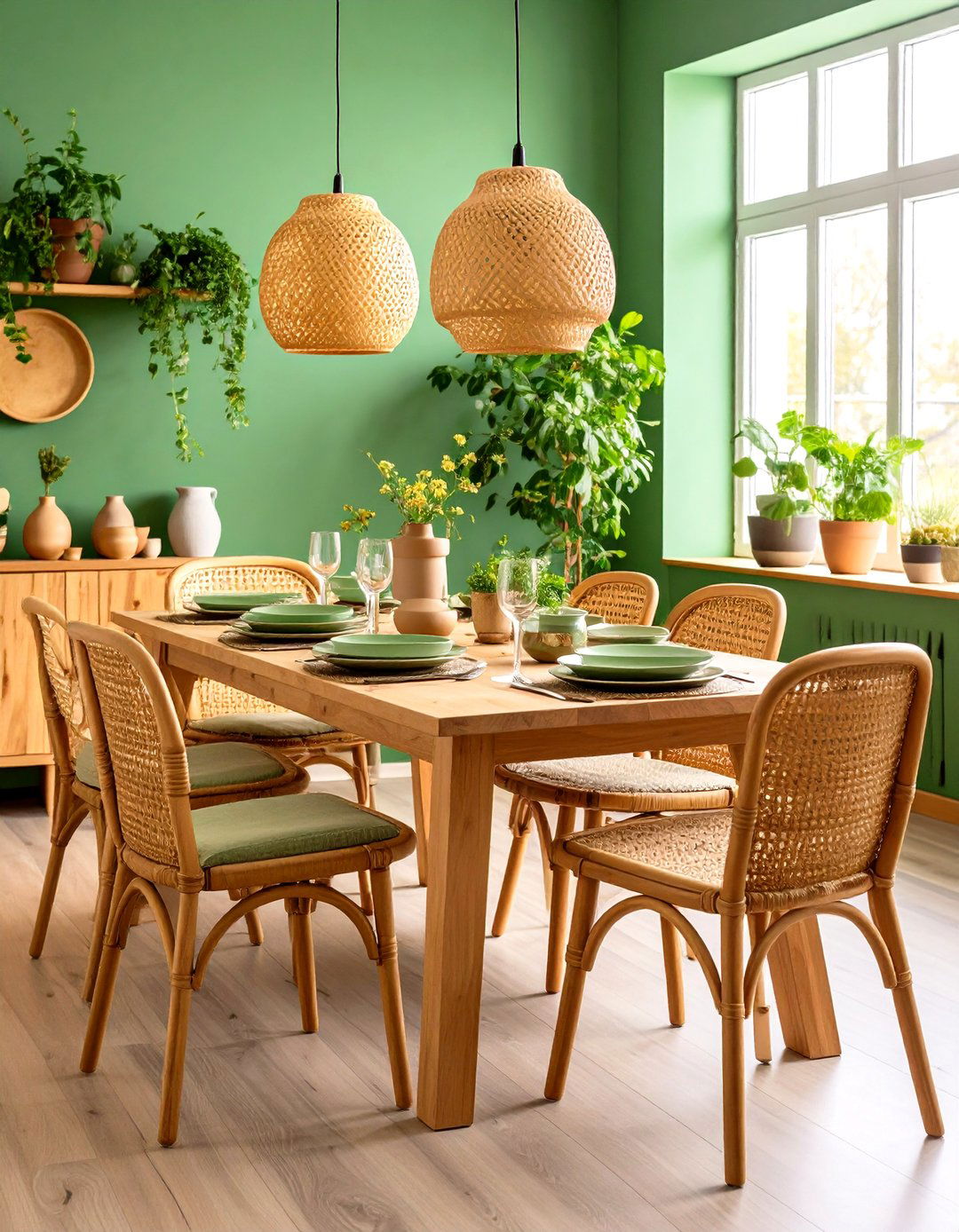
Building sustainability into a green dining room starts with the furniture, and nothing reads more authentic than a reclaimed-wood table carrying decades of patina. The weathered grain softly contrasts sage or olive walls and instantly grounds brighter chartreuse accents. Because each plank already has imperfections, you can relax about scratches from lively dinner parties: they simply add history. Pair the table with recycled-plastic woven chairs or vintage-store finds to keep the carbon footprint low, then finish the setting with linen napkins and locally fired ceramic plates. The mix telegraphs conscious living without ever feeling preachy, proving eco-friendly can still look richly inviting.
6. Two-Tone Green Dining Room Walls for Architectural Interest
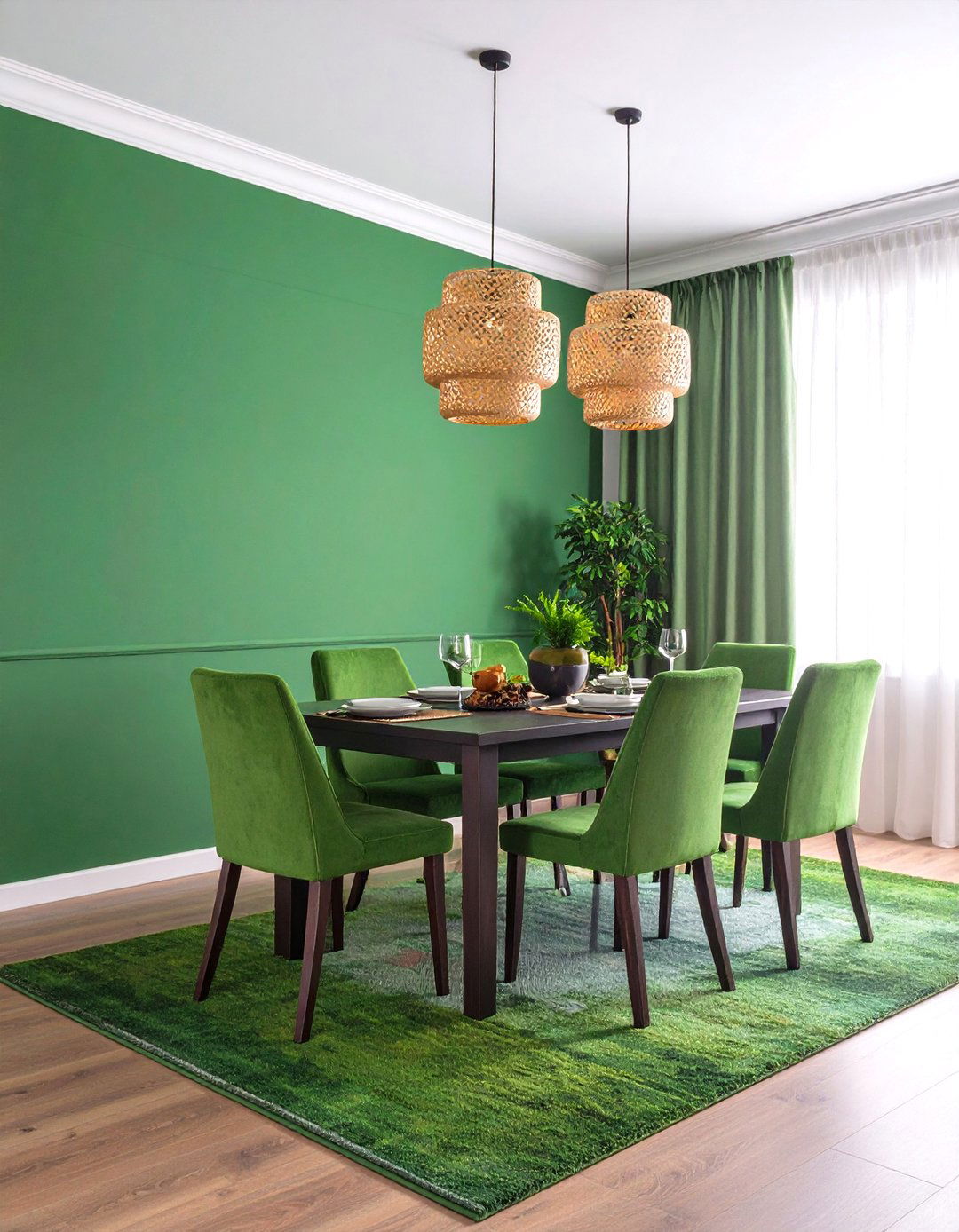
Take the guesswork out of wainscoting by painting the lower third of your green dining room in a darker spruce and the upper portion in a lighter celadon, instantly adding architecture even where none exists. The deeper base visually anchors furniture and hides scuffs from chair backs, while the airy top half keeps the room from feeling enclosed. A slim chair rail painted to match the lighter hue creates a crisp transition line that reads custom, not DIY. Complete the gradient with cushions that incorporate both values and a rug that pulls the palette together. The result is quietly dynamic and easy to refresh.
7. Retro Mint Green Dining Room Charm
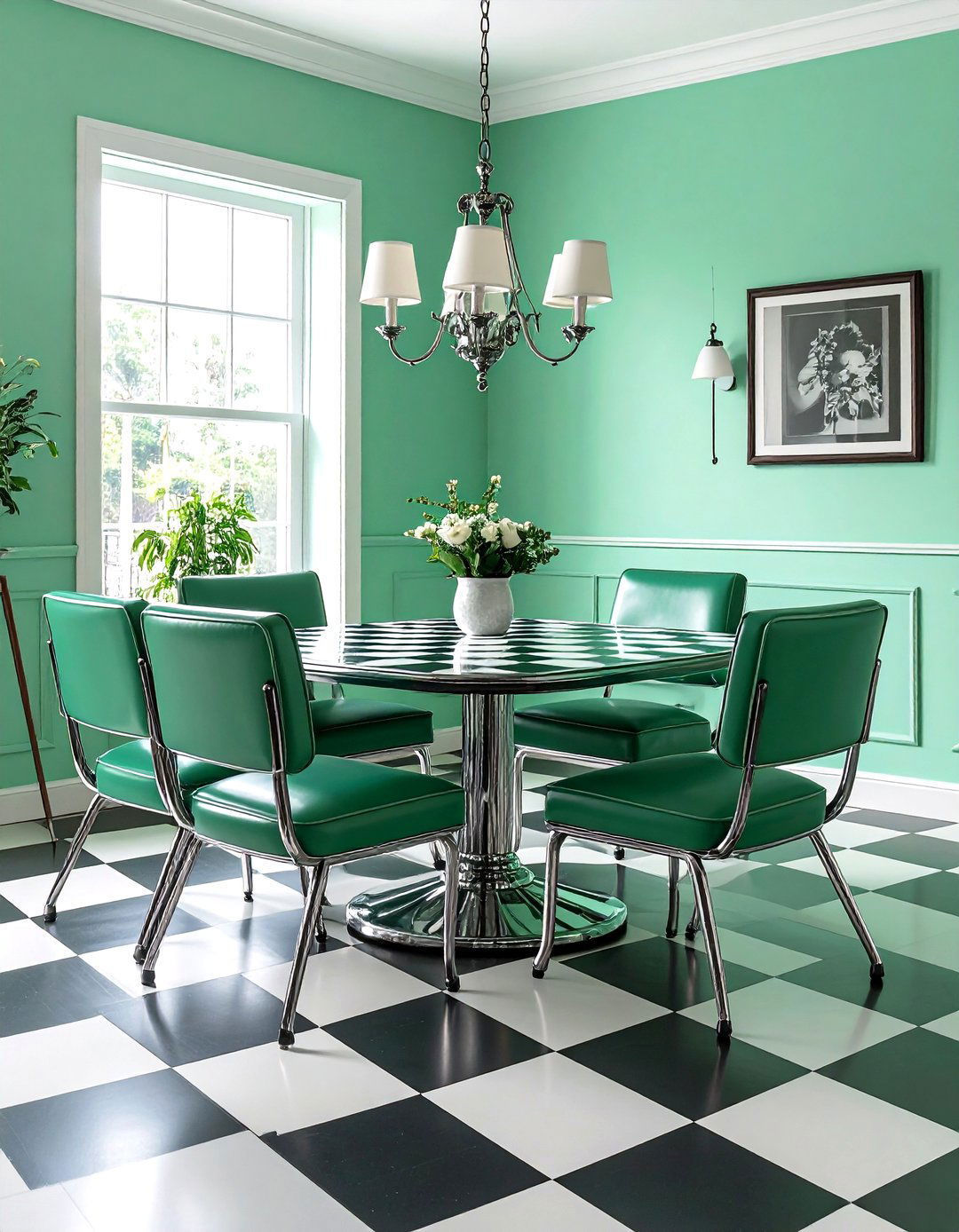
A mint-green palette evokes 1950s soda fountains, so if you crave nostalgia, let that playful pastel set the tone for your green dining room. Paint walls a soft spearmint and bring in chrome-leg café chairs or a vintage pedestal table to channel diner flair. Glossy subway tiles as a sideboard backsplash reinforce the retro vibe, while a checkerboard floor—white with pale gray—grounds the sweetness. Keep lighting simple: a schoolhouse globe or chunky frosted pendants echo mid-century lines. Round out the scene with milk-glass dishes and pops of coral or buttery yellow for a color combo straight from classic advertisements.
8. Vibrant Chartreuse Chairs in a Green Dining Room
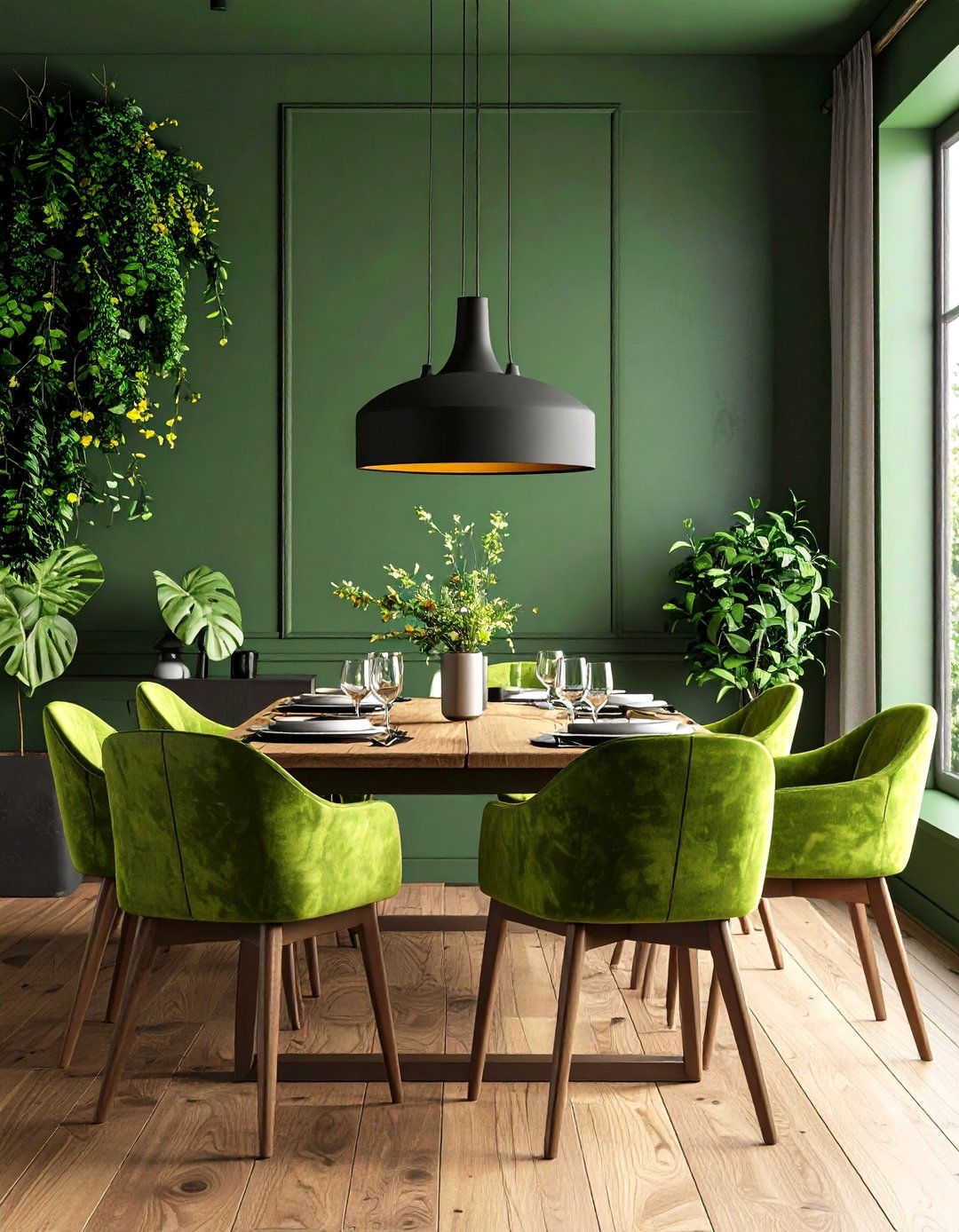
Surprisingly, the best way to make a sage or forest-painted green dining room feel modern is to introduce high-voltage chartreuse dining chairs that practically glow. Because the upholstery sits on the yellow edge of the spectrum, it creates instant contrast without abandoning the overall green story. To avoid overload, let the chairs be the only saturated piece; keep walls muted and choose an understated wood or metal table. A neutral sisal rug and matte black pendant allow the electric seating to sing. The eye-catching silhouette encourages guests to linger—finish the look with a single vase of white lilies to underline the citrus notes.
9. Cocooning Forest Green Dining Room Drama

Deep forest paint envelops a green dining room like velvet curtains, making evening meals feel intimate and theatrical. Choose an eggshell finish to catch candlelight, then layer walnut or black-stained furniture so the palette remains tonal and restful. Brass candlesticks, amber glassware, and smoky linen napkins echo the low-light ambience. If natural light is limited, add wall-mounted picture lights to spotlight artwork without breaking the moody spell. To prevent heaviness, keep ceilings bright white or install a vintage mirror that bounces glimmers of gold around the room, conjuring the cozy glamour of classic supper clubs.
10. Layered Green Textiles for a Soft Dining Room Palette

Soft furnishings are the easiest way to weave multiple shades together, and a layered approach turns a simple paint job into a multidimensional green dining room statement. Begin with a striped table runner shifting from eucalyptus to moss, then add velvet seat pads in a slightly darker hue for tonal depth. Sheer sage curtains filter daylight, casting a subtle glow that makes food colors pop. Mix textures—cotton, linen, chenille—so even monochrome fabrics read interesting. Finally, fold patterned napkins with micro-botanical prints at each place setting; the repetition of green unifies the tablescape while the prints supply movement and whimsy.
11. Green Dining Room Ceilings for an Unexpected Twist
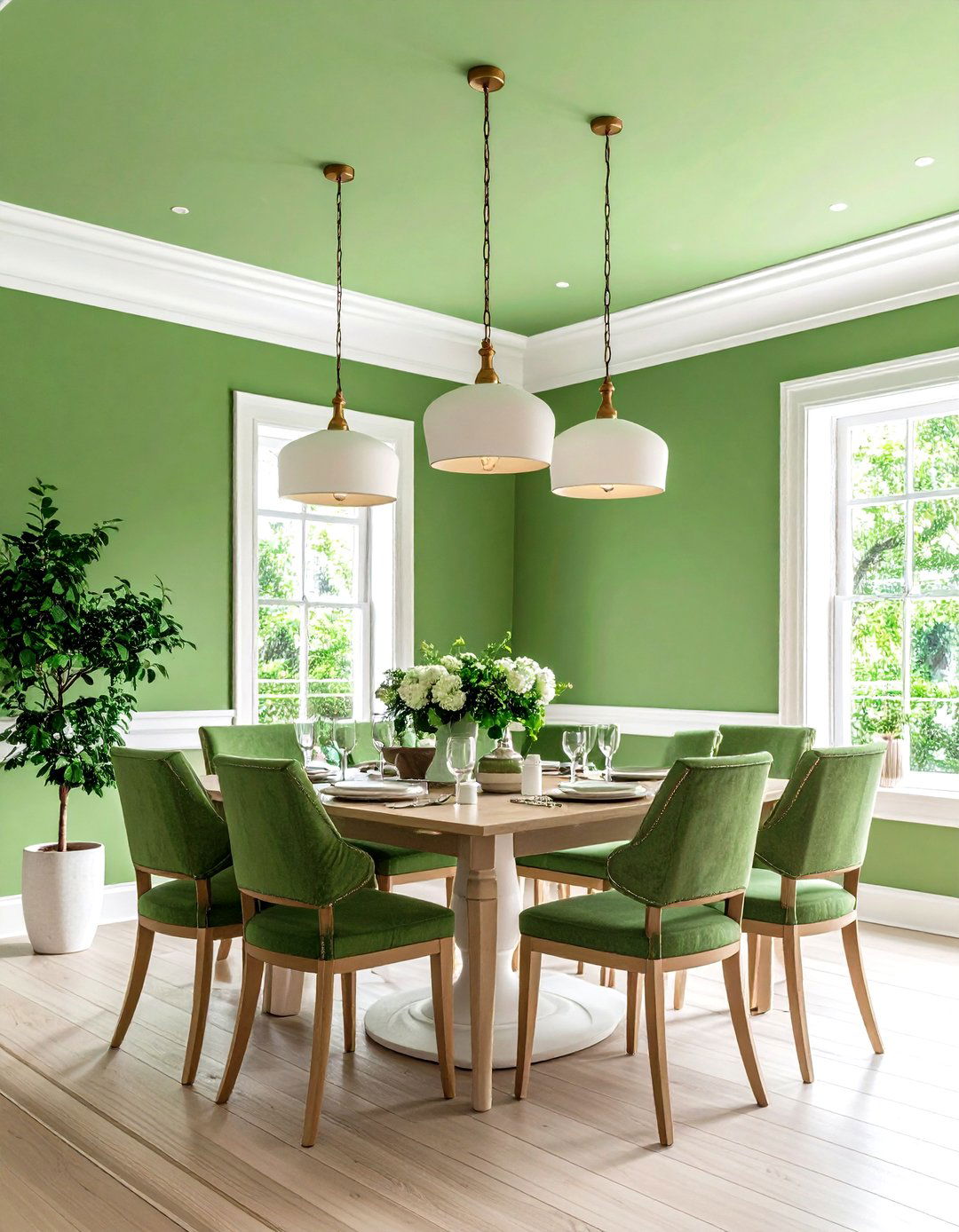
Painting the ceiling a soft pistachio immediately turns a green dining room into a contemporary jewel box without altering a single wall. The overhead color draws the eye upward, making pendant lights feel part of a cohesive composition rather than isolated fixtures. Pair the painted lid with neutral walls and trim so the effect reads intentional, not overwhelming. If you crave extra definition, use narrow white crown molding to frame the hue. The gentle surprise encourages guests to look around—and above—sparking conversation about a detail most rooms overlook. Bonus: the reflective surface subtly flatters skin tones during candlelit dinners.
12. Metallic Lighting to Highlight a Green Dining Room
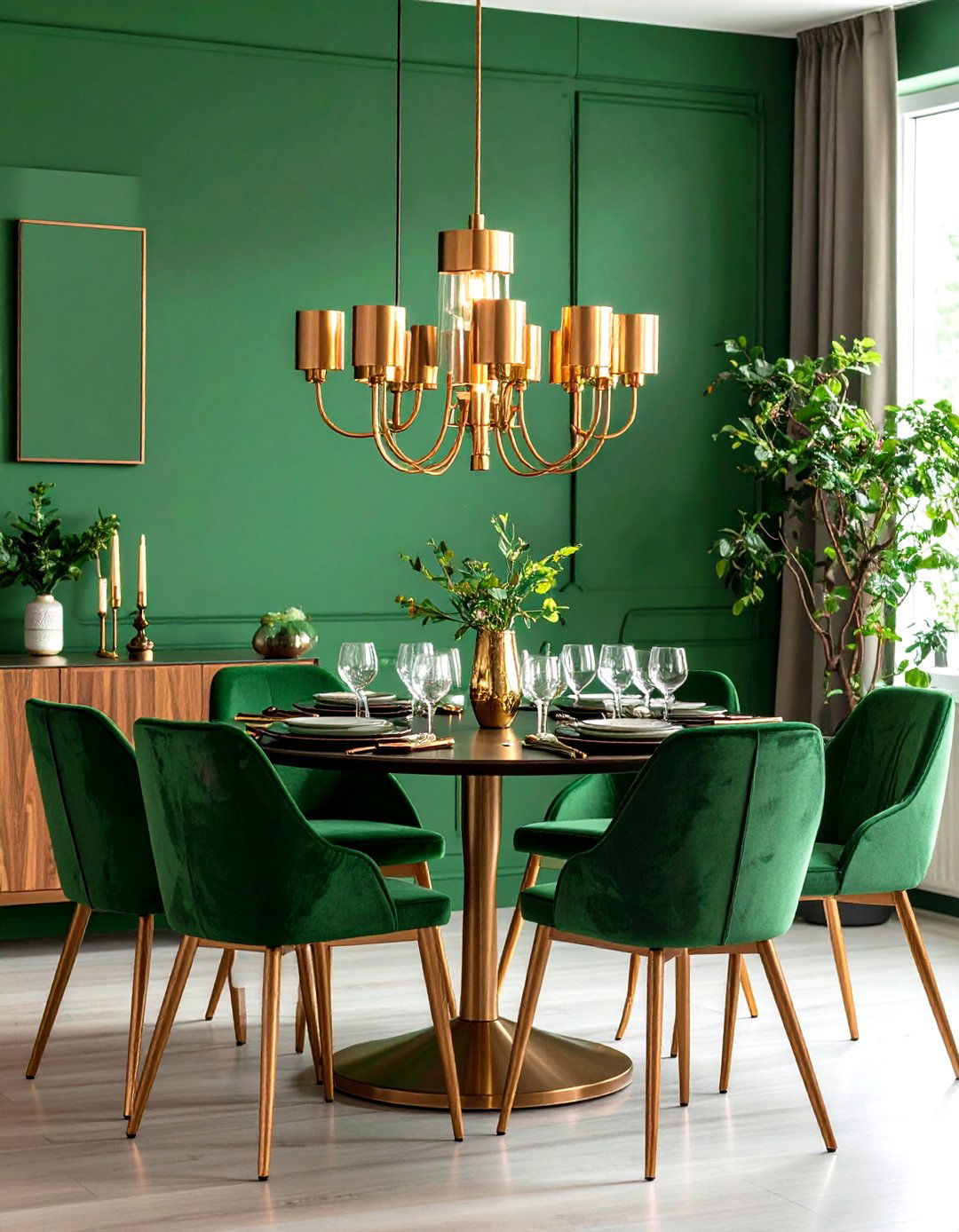
Metallic fixtures act like jewelry against green, so swapping a standard pendant for a brushed-gold Sputnik instantly adds sparkle to a green dining room. Warm metals bounce light, enhancing both deep emeralds and subdued sages while avoiding the cool clash chrome can introduce. Complement the overhead statement with slim brass picture lights or antique-finish wall sconces to create layered illumination. If you prefer subtler shine, choose fixtures in burnished copper; the pink undertone pairs beautifully with olive walls. Remember to install dimmers so the metal can glow softly over dessert or shimmer brightly during family brunch.
13. Curated Green Ceramics Display
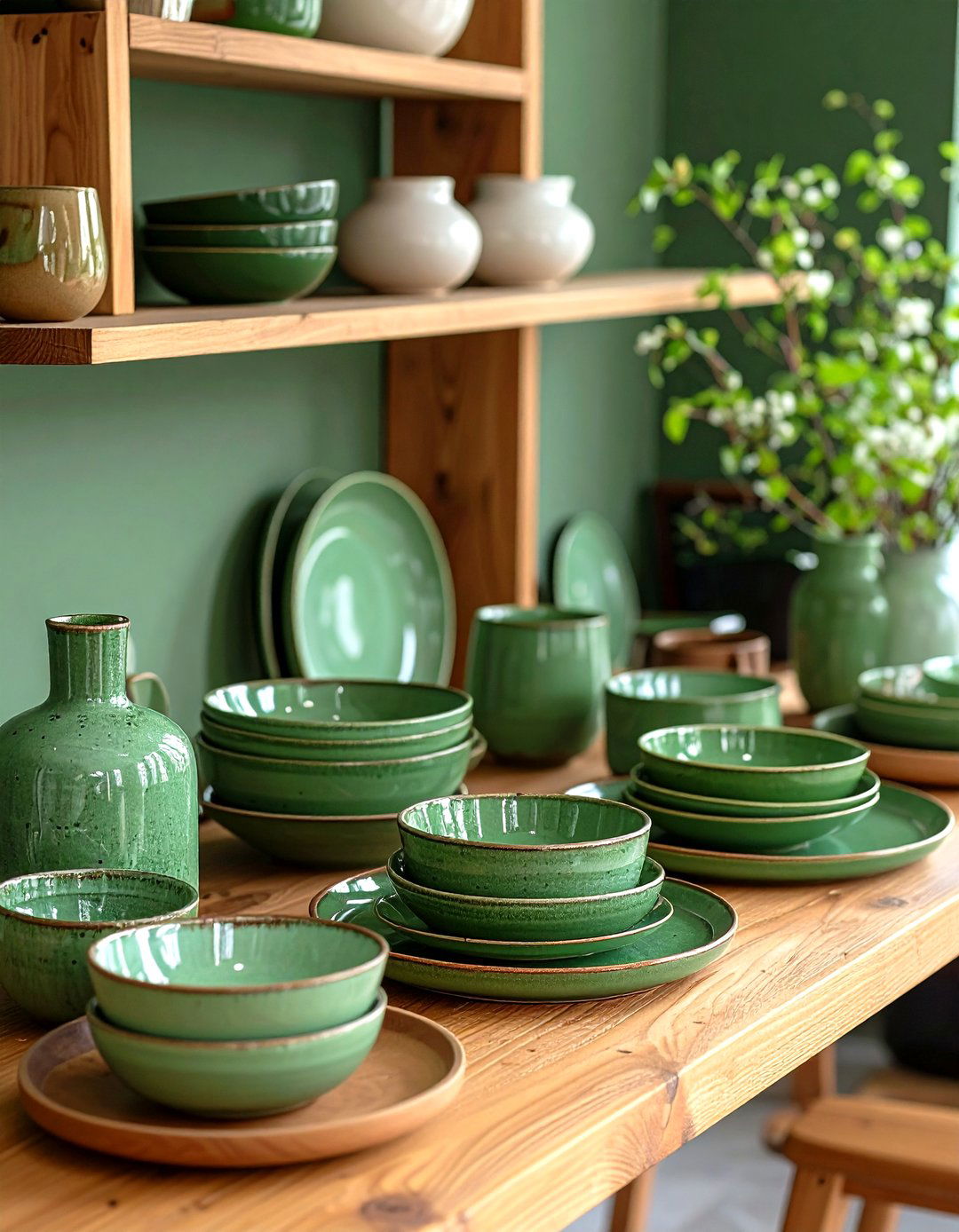
A plate rail or shallow floating shelf lets jadeite plates, celadon bowls, and hand-thrown sage mugs turn tableware into art and layer your green dining room with texture. Arrange pieces by tone—from palest mint to darkest juniper—so the gradient reads intentional. Mixing matte and glossy glazes adds rhythm, while repetition of rounded silhouettes keeps the display calm. When dinner starts, reaching for serving pieces from the wall reinforces the connection between decor and function. Because the collection can grow over time, you’re free to swap in seasonal accents—cranberry plates at holidays, sand-colored ones in summer—without rearranging furniture.
14. Natural-Fiber Rugs to Ground a Green Dining Room
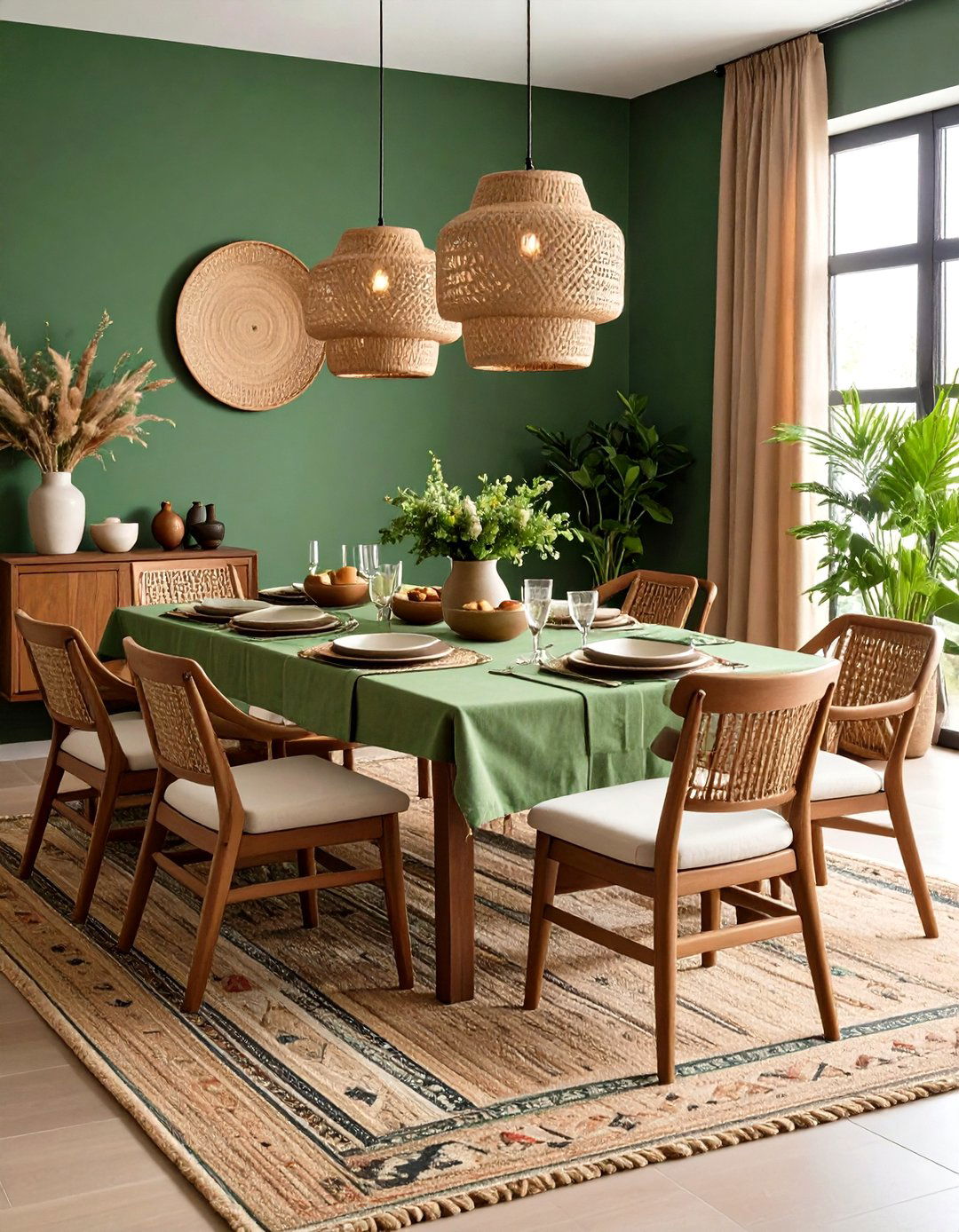
A jute or sisal rug underfoot tempers rich color schemes by adding organic warmth, making it a perfect anchor for any shade of green dining room. Choose a tight flat-weave that stands up to chair movement, or layer a washable cotton kilim over the natural mat for pattern interest. Earthy fibers highlight the botanical undertones of green while contrasting luxurious elements—think velvet drapes or metallic lighting. Stick with neutral wheat or tobacco tones so spills disguise easily and the eye focuses on table styling. The tactile weave also improves acoustics, softening echoes so conversation feels more intimate.
15. Partitioned Open-Plan Green Dining Room Zones
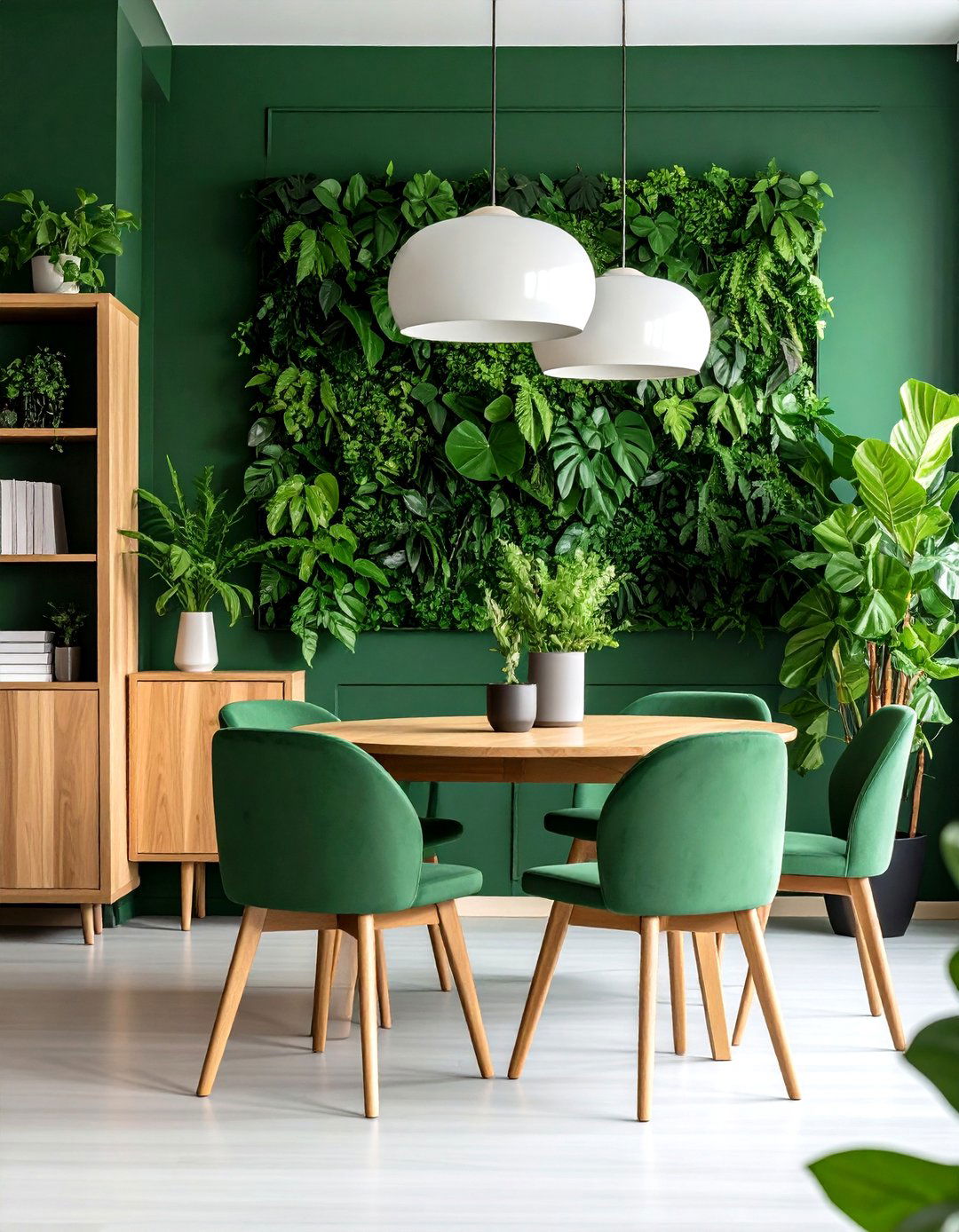
In open-plan layouts, color becomes a subtle room divider, and a concentrated wash of leafy paint on a single wall can carve out a dedicated green dining room even when it shares floors with the kitchen or lounge. Choose the wall behind the head chairs so the hue frames guests in photos and anchors the table visually. Echo the tone in smaller accents—perhaps a painted console or art mat—to stitch the zone back into the larger scheme. A floor-standing planter or low bookcase painted to match provides extra definition without blocking light. The result feels intentional yet airy.
16. Seasonal Tablescapes for a Dynamic Green Dining Room

Refreshing your green dining room can be as simple as swapping the centerpiece each season, letting the walls remain constant while the table tells new stories. In spring, cluster bud vases of hellebores and tulips; summer calls for bowls of limes and glossy monstera leaves. Come autumn, layer rust-toned linens over moss chargers, then lean into winter with mercury-glass candleholders and cedar sprigs. Because green harmonizes with both warm and cool palettes, every seasonal accent appears deliberate. Rotate napkin rings, menu cards, and chair cushions simultaneously, and guests will think you redesigned the whole space—even though only the tablescape shifted.
17. Botanical Art Gallery in a Green Dining Room
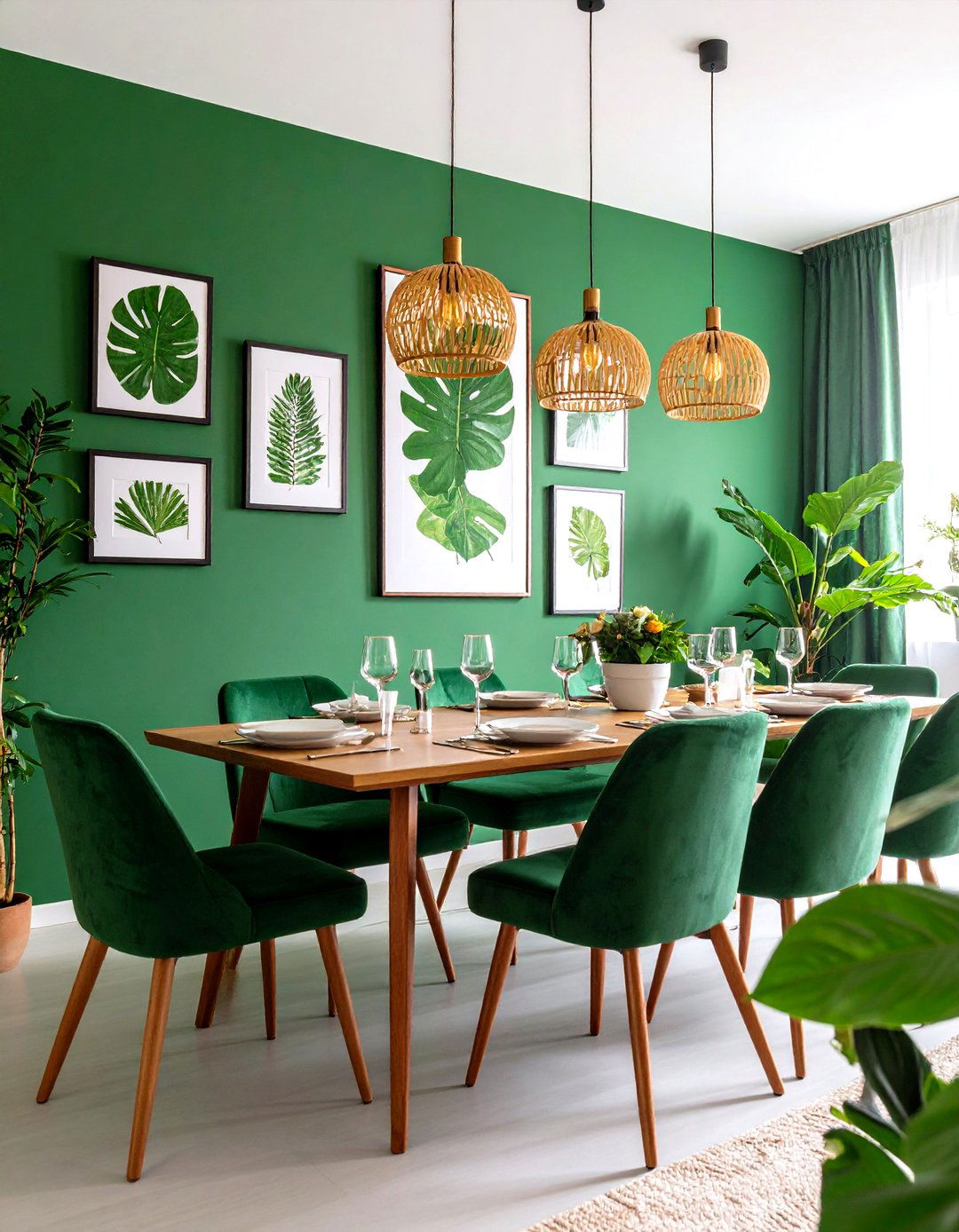
Framing vintage herbarium prints or oversized leaf photographs turns wall space into an educational gallery and reinforces the natural theme already present in a green dining room. Arrange pieces salon-style across one wall, mixing frame finishes—black, oak, antique gold—to echo other metals and woods in the room. Vary mat sizes so the eye dances from piece to piece, then light the collection with slim picture lights that double as mood setting. For unity, pull a dominant green from the artwork into seat cushions or glassware. The result feels curated, intellectual, and deeply connected to the outdoors.
18. Low-VOC Paint Choices for a Healthier Green Dining Room
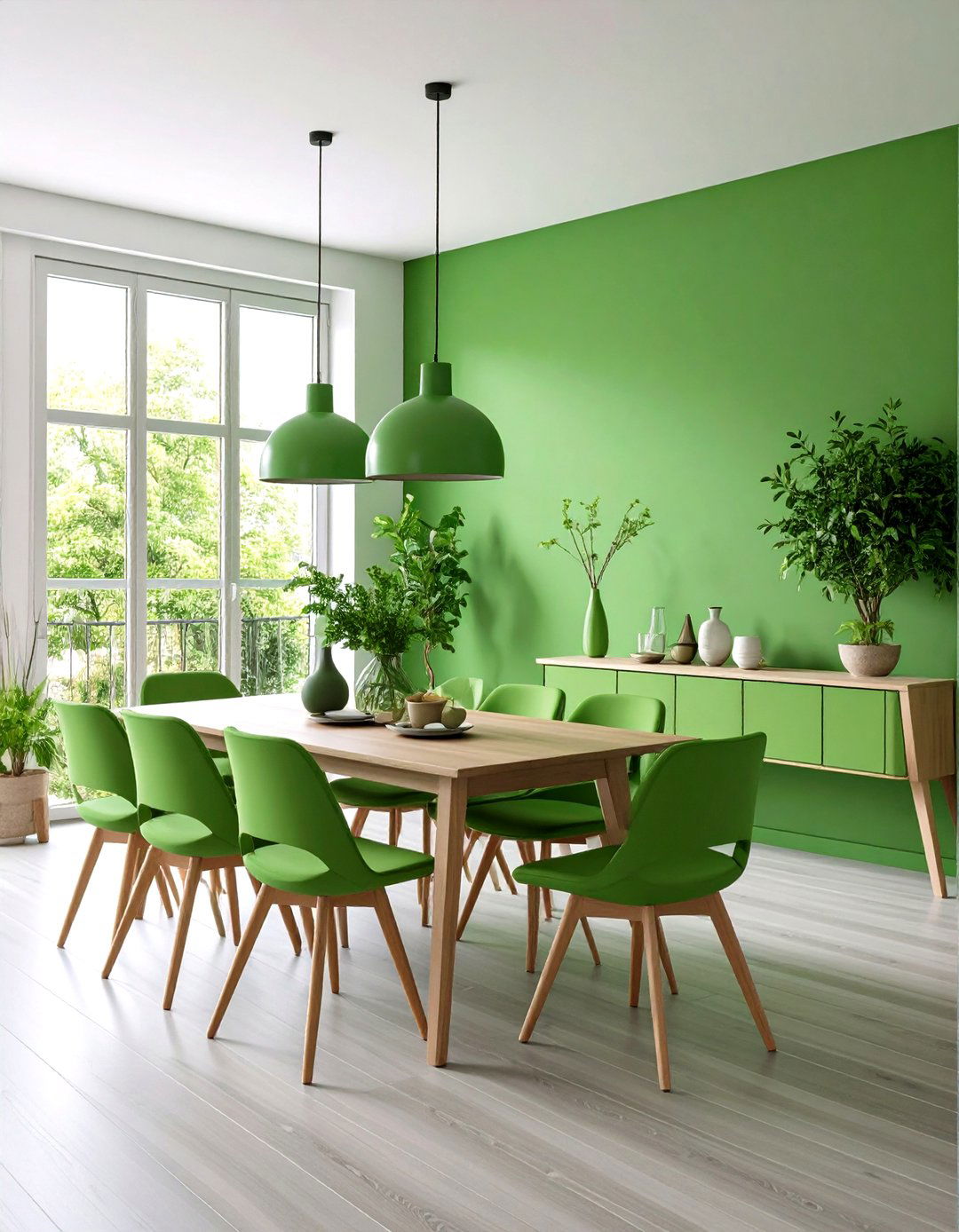
The color may be lush, but the air should stay clean, so opt for low- or zero-VOC formulations when painting a green dining room. These finishes release far fewer chemicals, letting you host a dinner party the same week without lingering odors. Many brands now offer deep emeralds and subtle sages in eco-lines, meaning you don’t sacrifice vibrancy for health. A bonus: low-VOC paints resist yellowing, keeping your chosen hue true for years. Always prime with the matching eco-system, then ventilate for 48 hours; you’ll protect both guests and the planet while achieving the exact shade you love.
19. Small-Space Green Dining Nooks
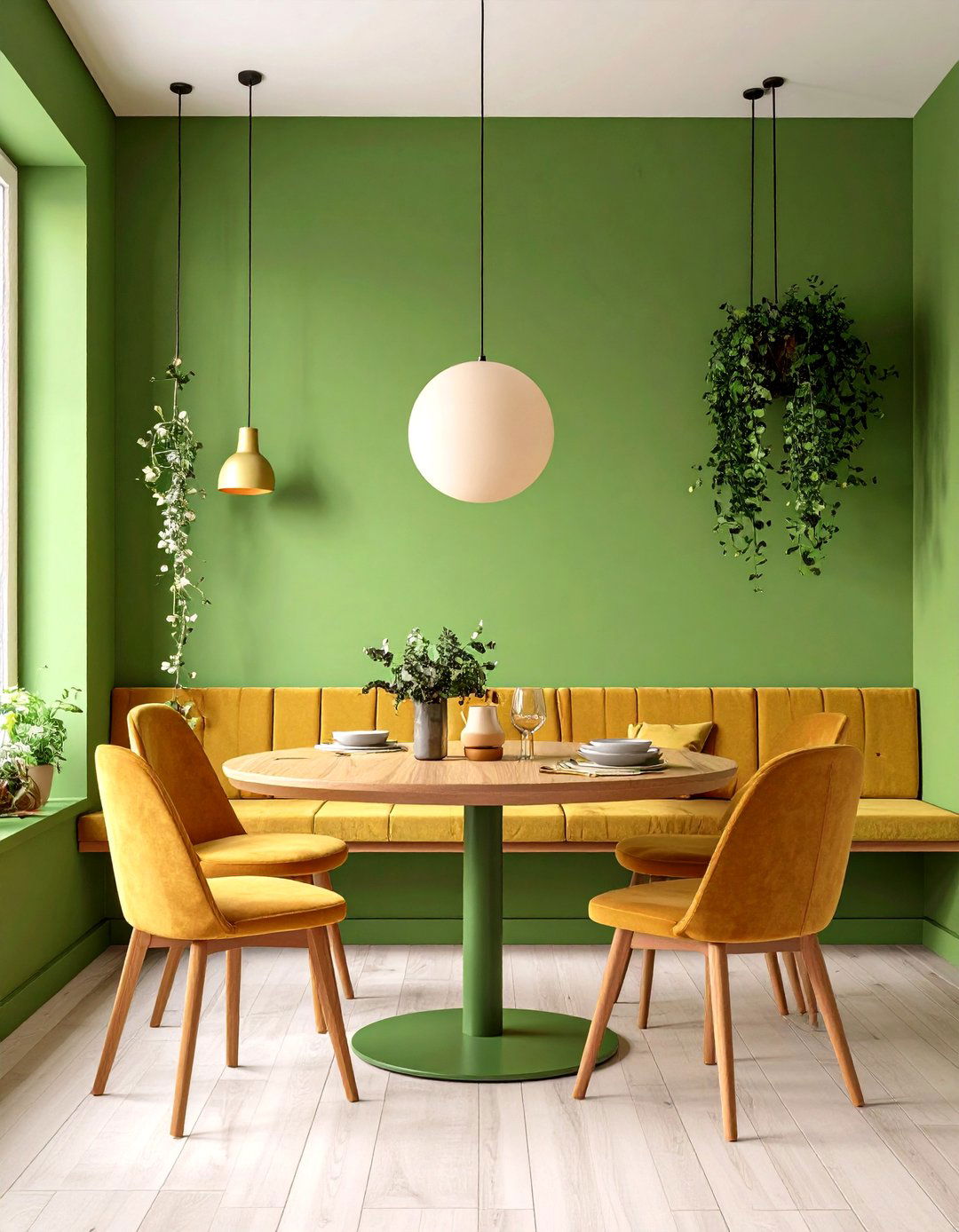
Even the tiniest breakfast alcove can claim personality when you embrace color blocking and turn it into a pocket-size green dining room. Paint the back wall a bright pea hue, then add a floating bench upholstered in tone-on-tone fabric to save floor space. A round pedestal table allows easier traffic flow and mirrors the curvature of built-in seating. Hang a petite globe pendant at eye level to define the zone and choose slim ladder-back chairs that tuck completely under the tabletop. Reflect light with a wall-mounted mirror, and the nook suddenly feels grander than its dimensions suggest.
20. Warm Wood Pairings in a Transitional Green Dining Room
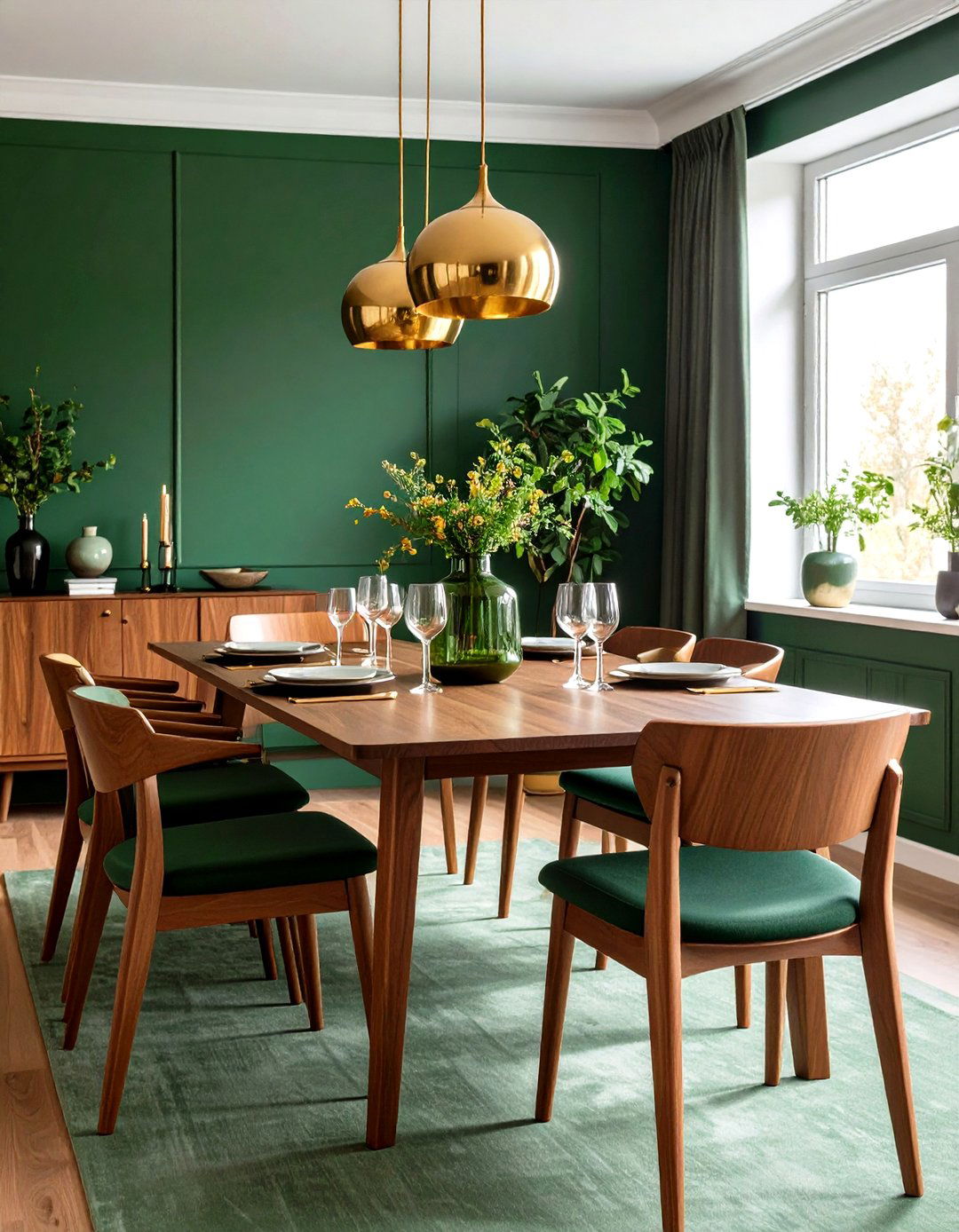
Transitional style balances classic and contemporary, and nothing delivers that equilibrium faster than combining rich wood tones with cool paint in a green dining room. Walnut tabletops and oak wishbone chairs lend tactile warmth that softens the assertiveness of emerald or teal walls. The wood’s visible grain introduces pattern without adding competing colors, making styling effortless—simple linen runners, earthenware plates, and an olive-green glass vase are all you need. Brass hardware bridges the palette, echoing both the golden undertones of timber and the depth of the paint. The result feels relaxed yet refined, inviting everyday meals and celebratory feasts alike.
Conclusion:
Green endures because it flexes with style and season: sage soothes, emerald dazzles, and olive grounds. By experimenting with wall treatments, furniture choices, lighting, and living elements, you can tailor a green dining room that mirrors your personality while offering the universal benefits of calm, appetite-friendly color psychology and eco-minded design. From reclaimed tables to low-VOC paints, each idea underscores how sustainability and beauty can coexist. Let these twenty approaches inspire fearless play with tone and texture, and you’ll find that every meal—whether a quick weekday breakfast or a long celebratory supper—feels elevated by the quiet power of green.


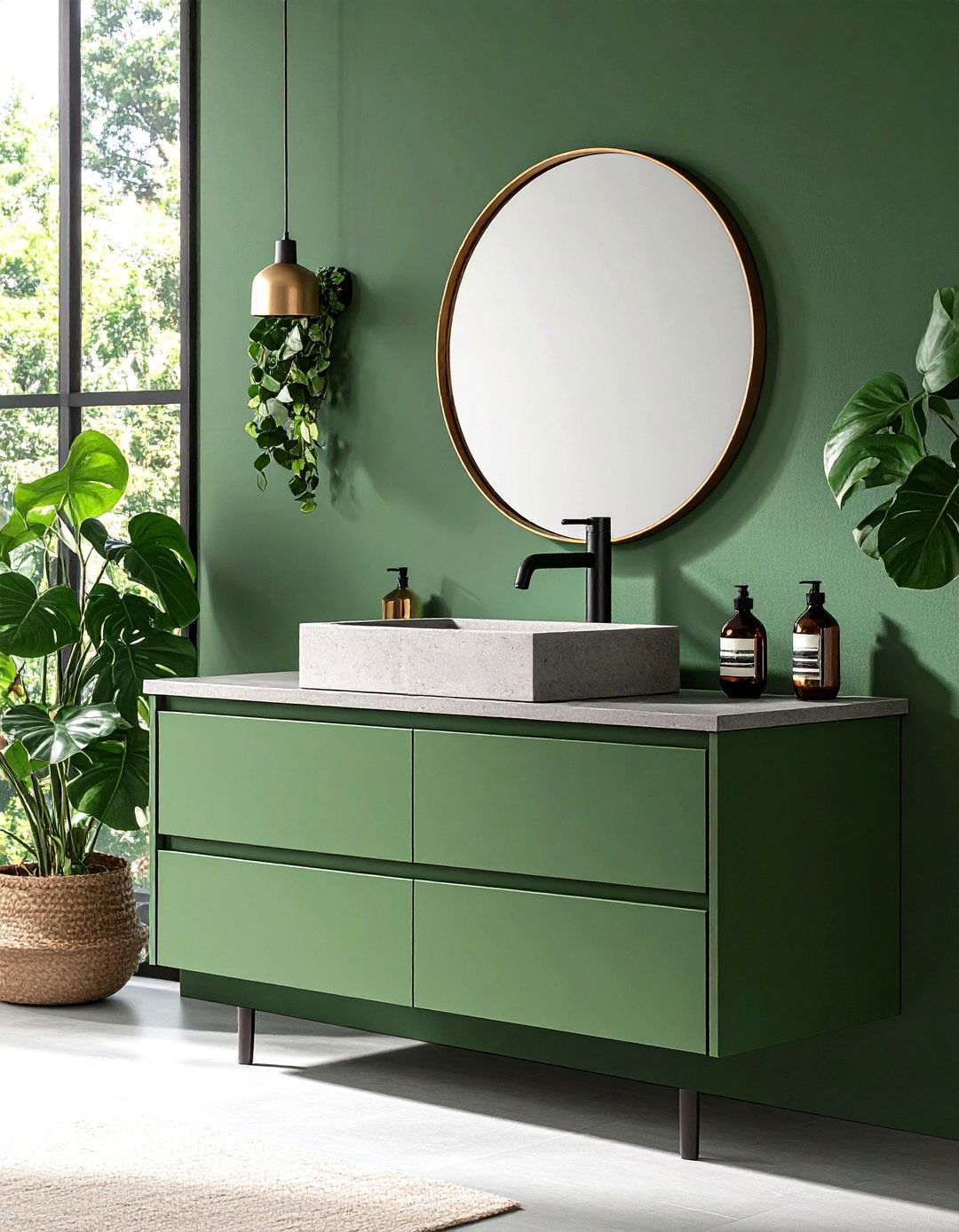
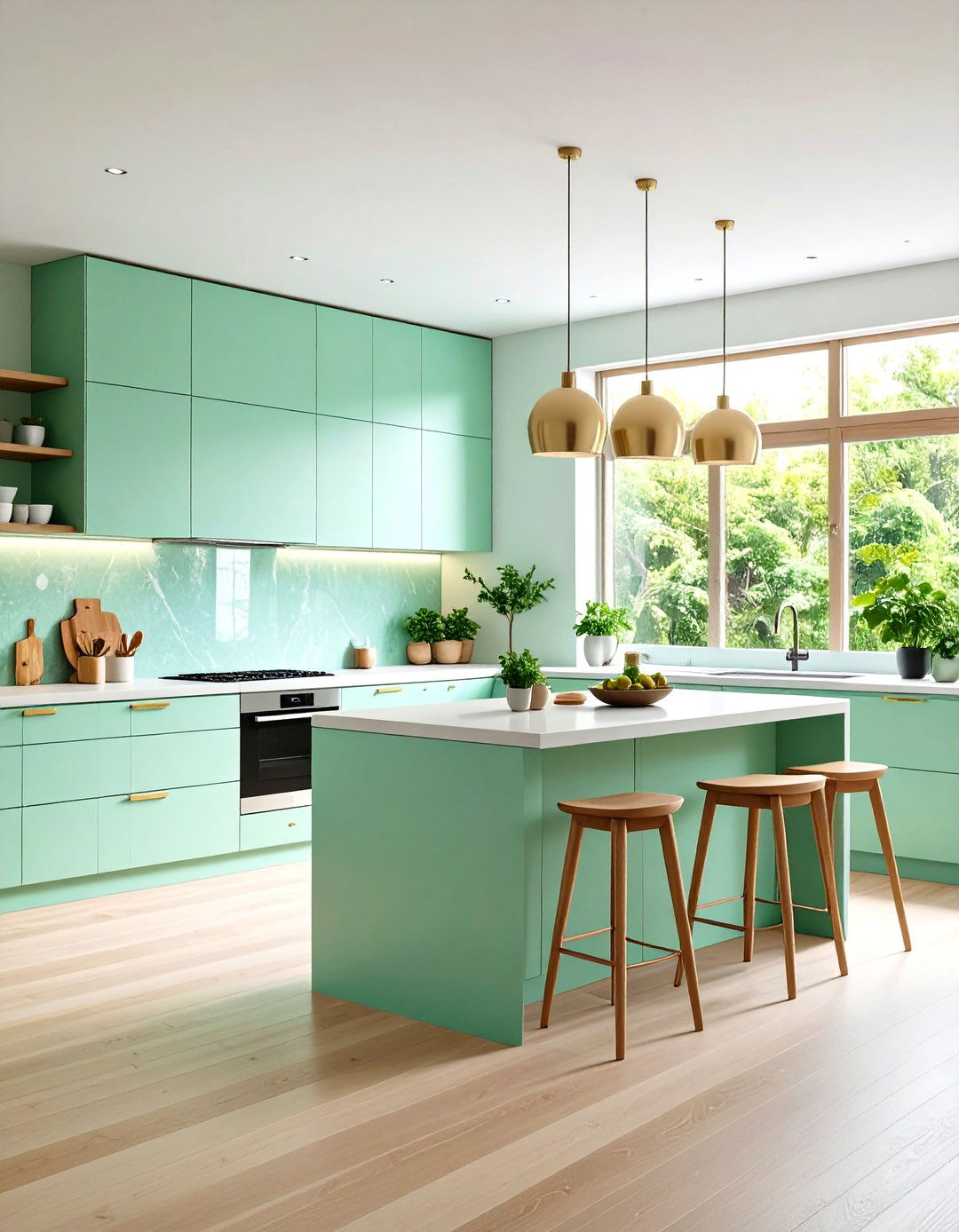

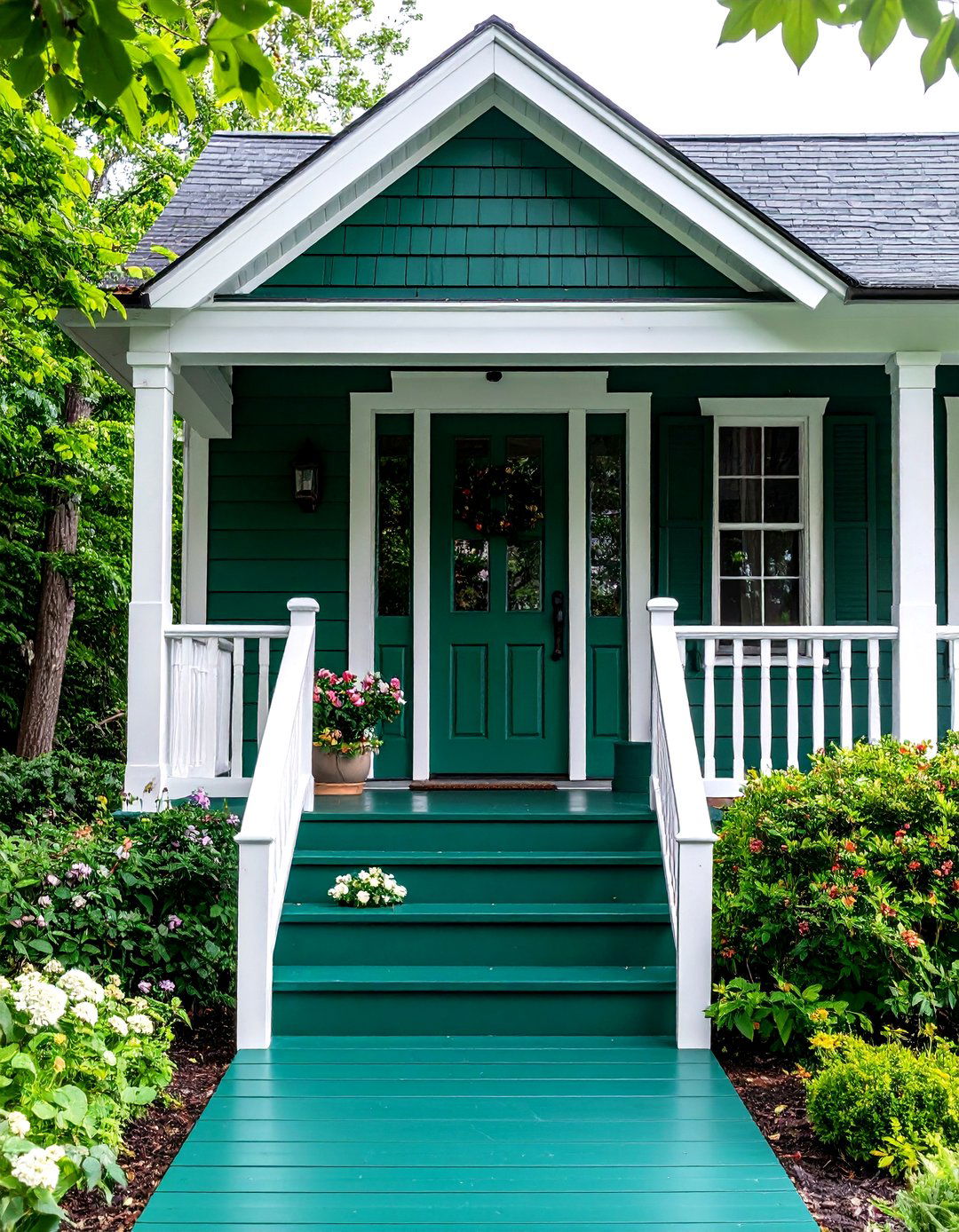
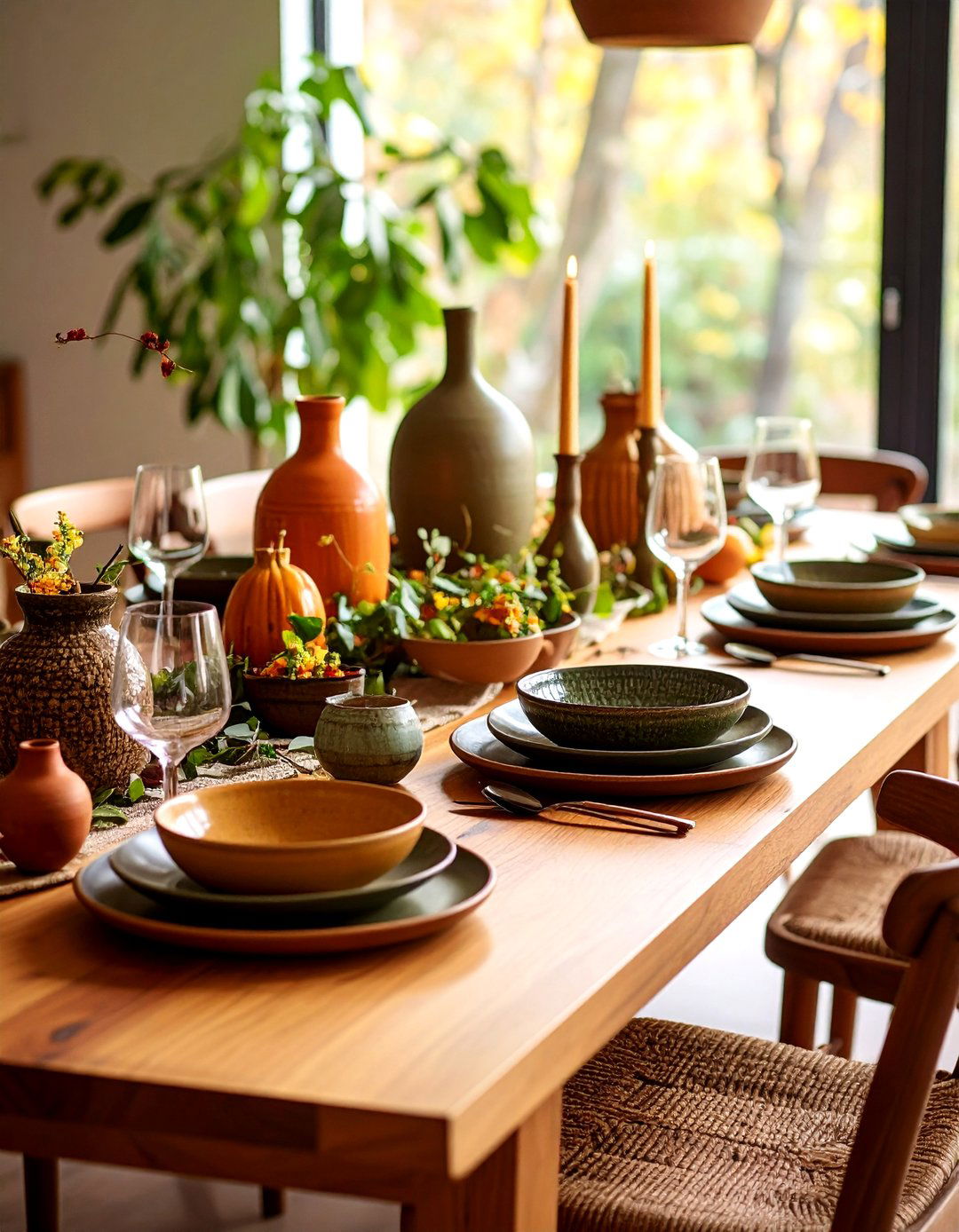

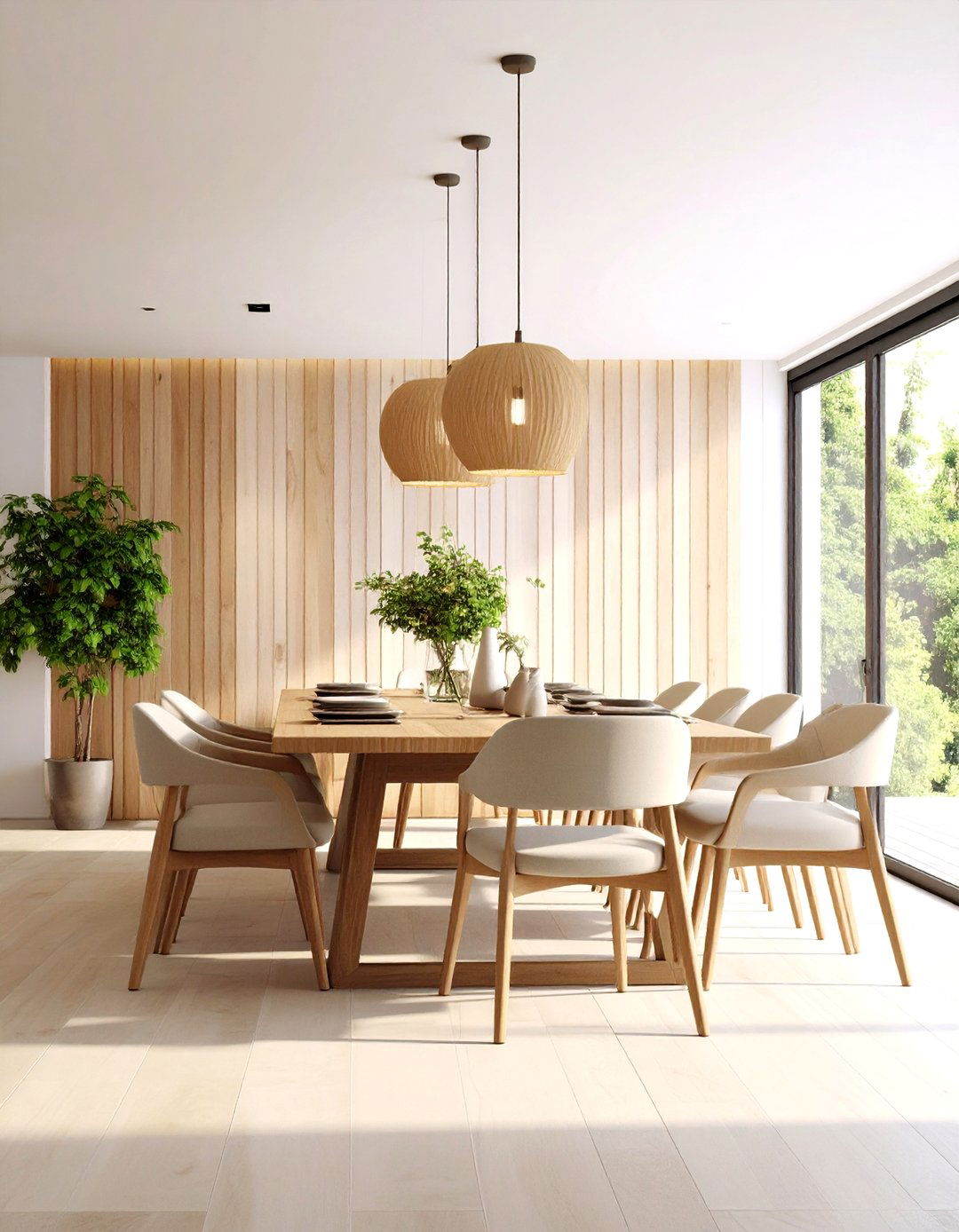
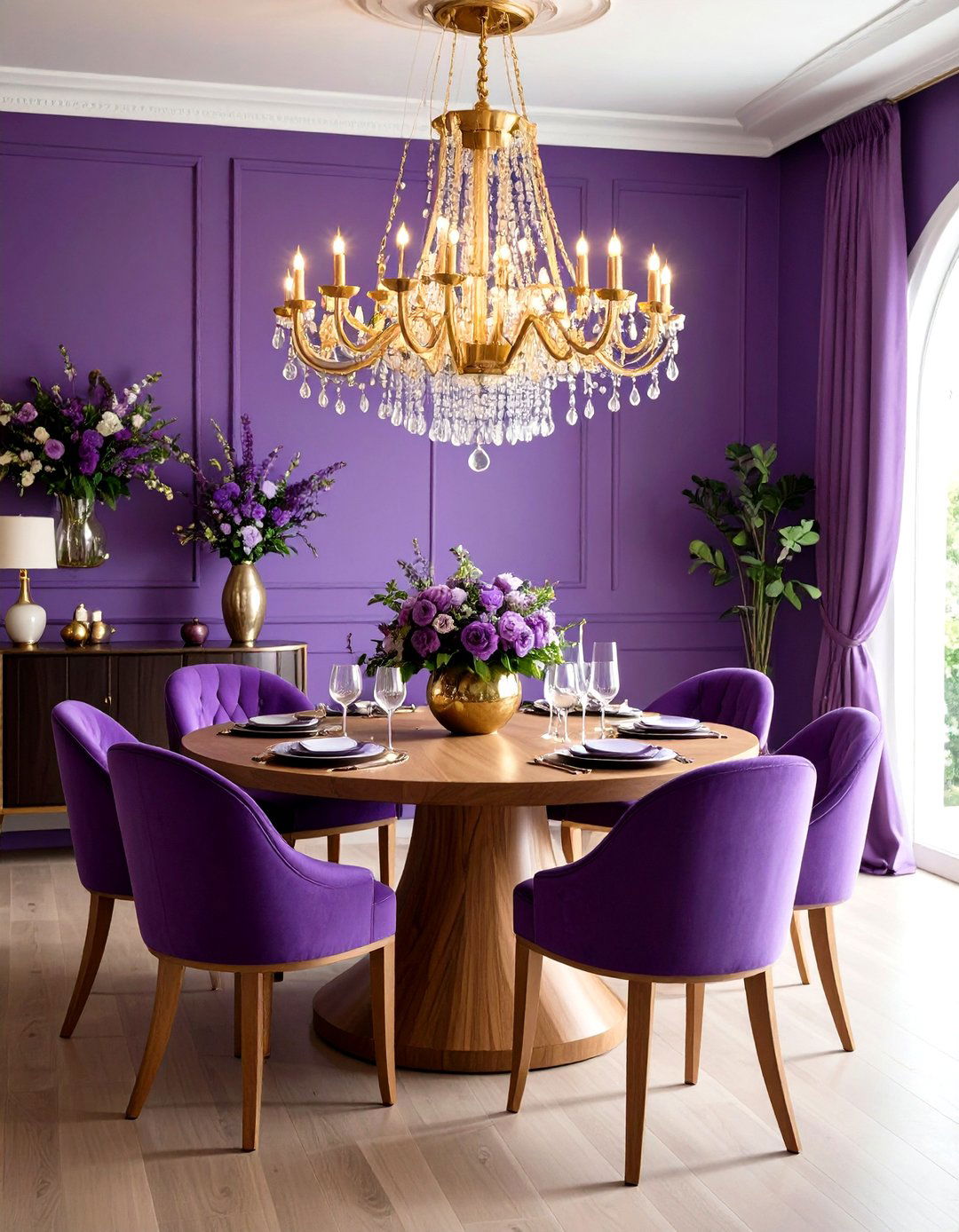

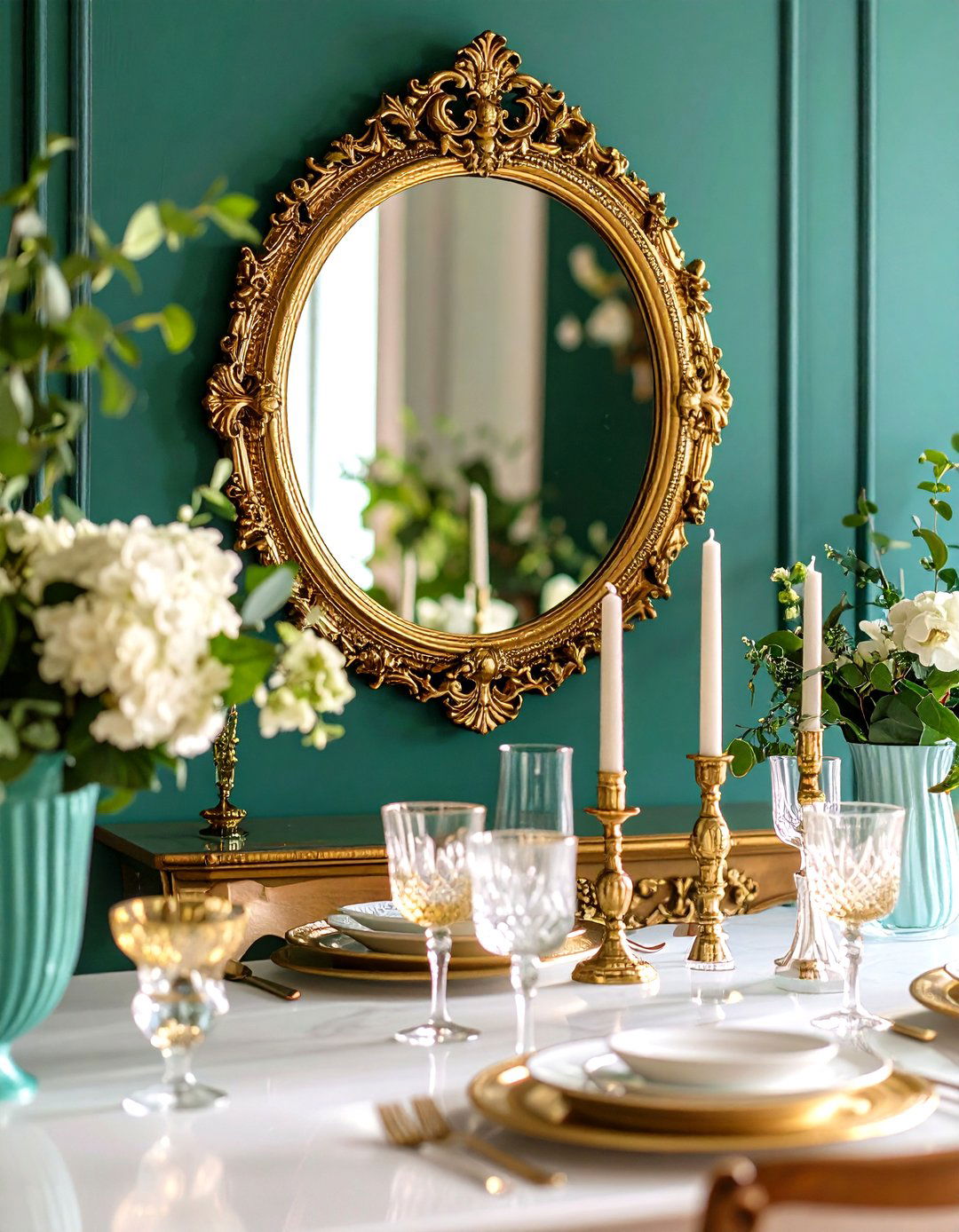
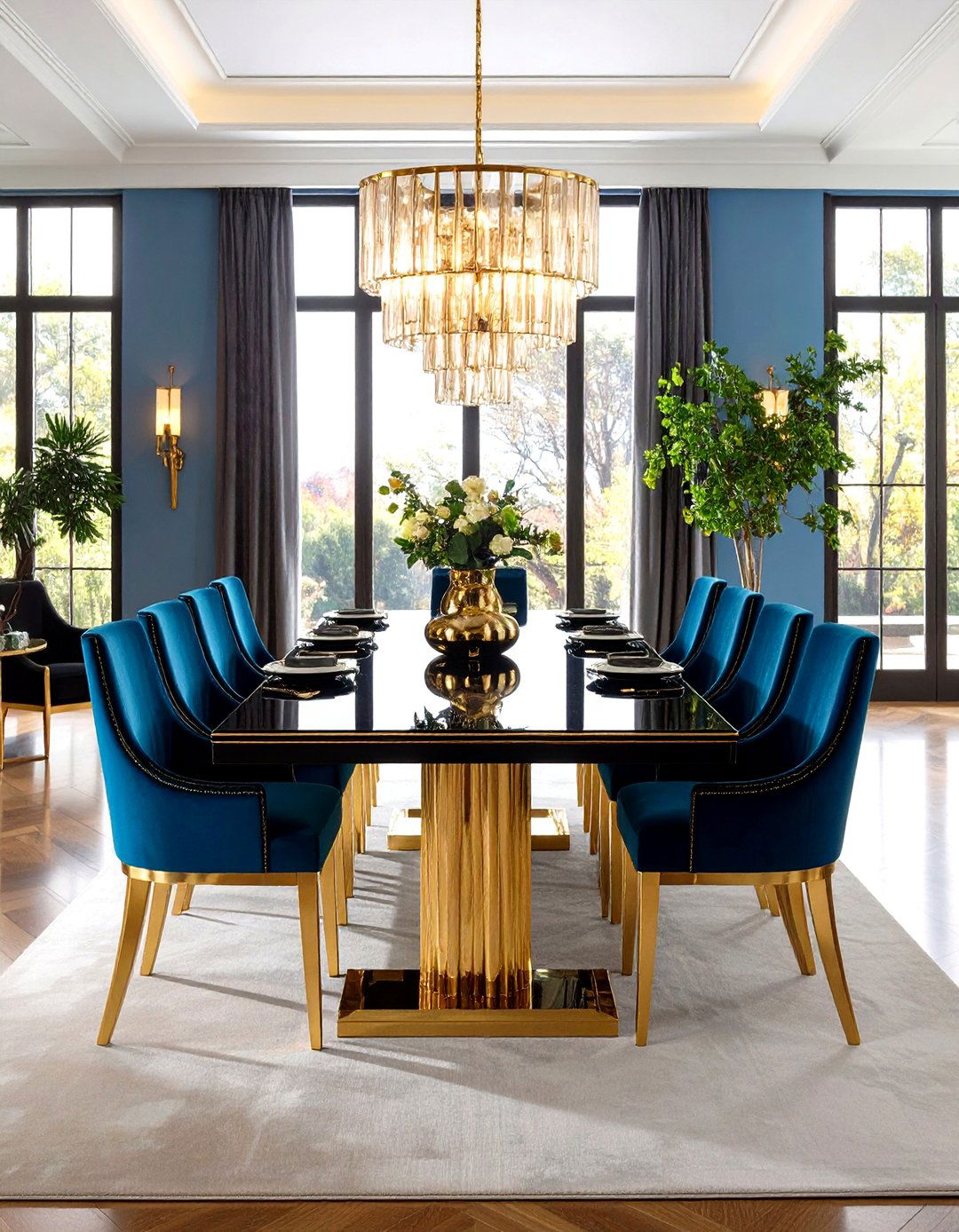
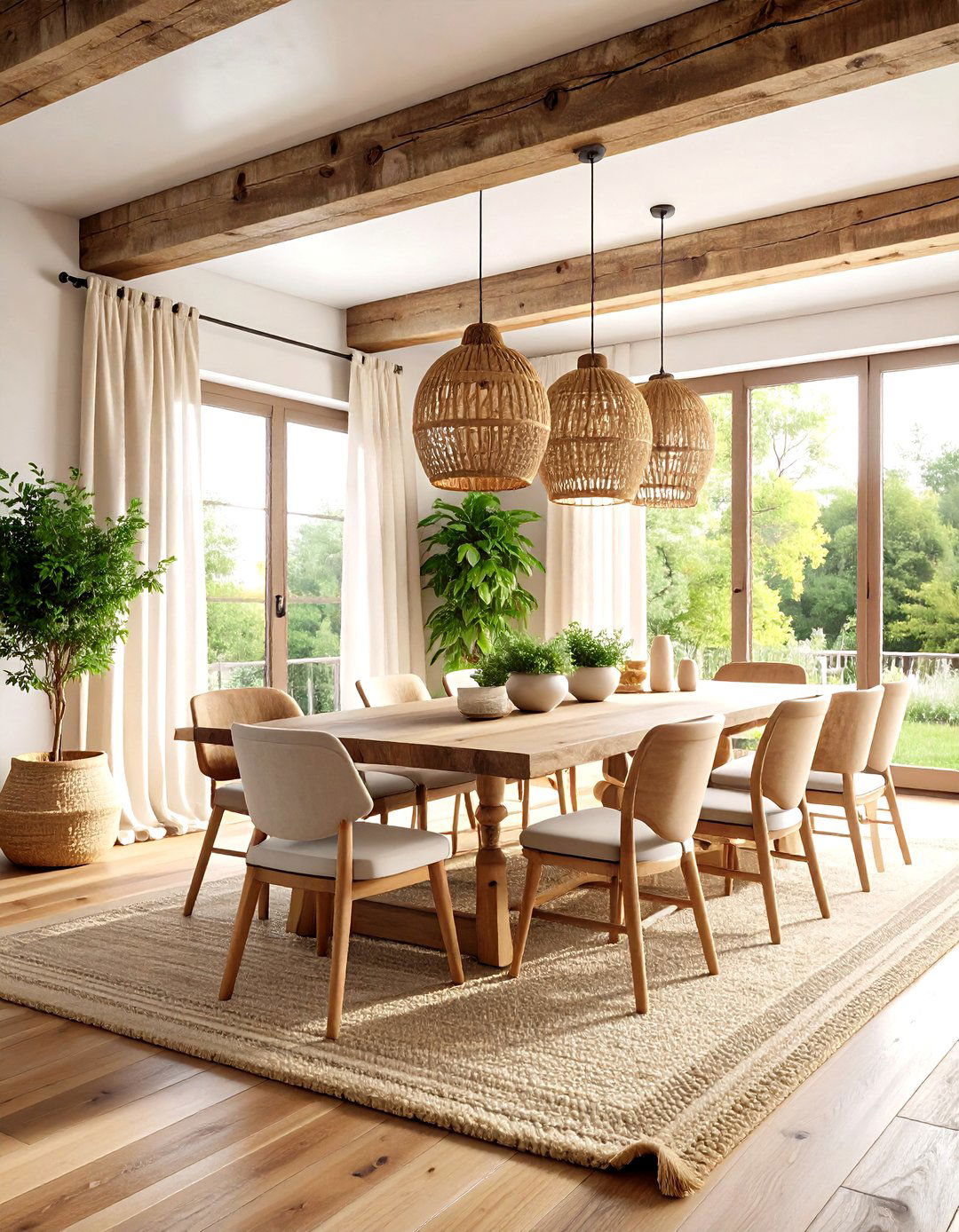
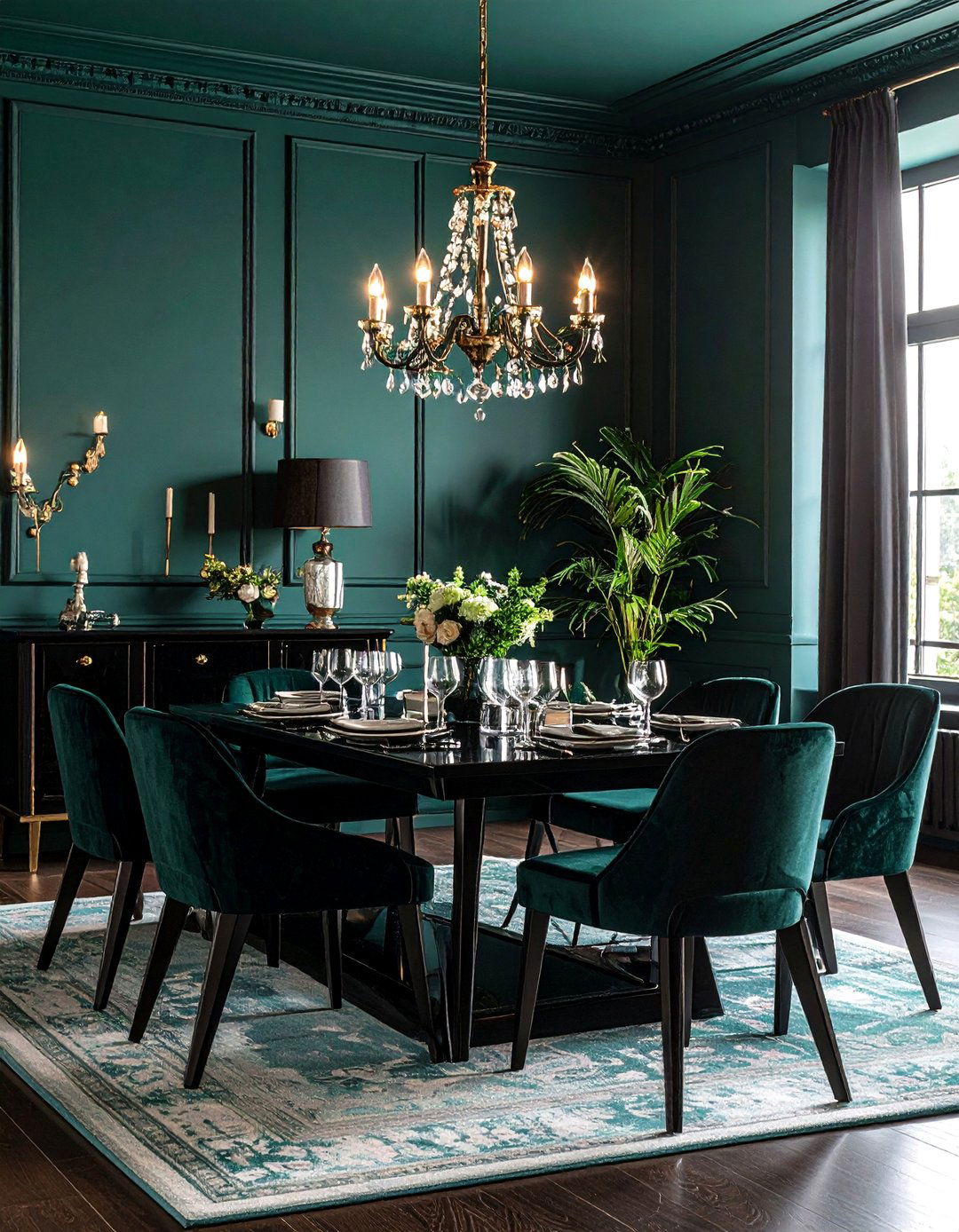
Leave a Reply